Related Research Articles
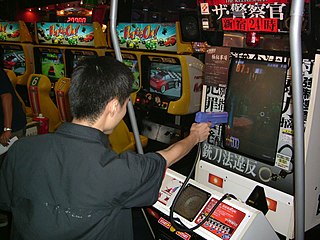
An arcade video game takes player input from its controls, processes it through electrical or computerized components, and displays output to an electronic monitor or similar display. All arcade video games are coin-operated or accept other means of payment, housed in an arcade cabinet, and located in amusement arcades alongside other kinds of arcade games. Until the early 2000s, arcade video games were the largest and most technologically advanced segment of the video game industry.
The Japan Amusement Machine and Marketing Association is a Japanese trade association headquartered in Tokyo.
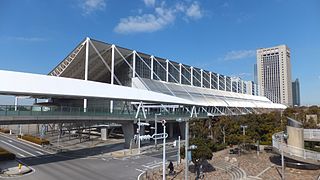
Makuhari Messe (幕張メッセ) is a Japanese convention center outside Tokyo, located in the Mihama-ku ward of Chiba City, in the northwest corner of Chiba Prefecture. Designed by Fumihiko Maki, it is accessible by Tokyo's commuter rail system. Makuhari is the name of the area, and Messe is a German language word meaning "trade fair".

Astron Belt (アストロンベルト) is a LaserDisc video game in the form of a third-person, space combat rail shooter, released in arcades in 1983 by Sega in Japan, and licensed to Bally Midway for release in North America. Developed in 1982, it was the first major arcade laserdisc video game. The game combines full-motion video (FMV) footage from the laserdisc with real-time 2D graphics. The arcade game was available in both upright and cockpit arcade cabinets, with the latter having illuminated buttons on the control panel, a larger 25" monitor, and a force feedback vibrating seat.

Virtua Fighter 3 is the sequel to 1994's Virtua Fighter 2 and the third fighting game in the Virtua Fighter series, developed by Sega AM2 and published by Sega in 1996. It was the first arcade game to run on the Sega Model 3 system board.
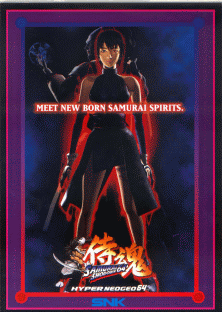
Samurai Shodown 64, known as Samurai Spirits in Japan, is a 3D fighting game produced by SNK for its Hyper Neo-Geo 64 system. It was SNK's first 3D fighting game. After having released four Samurai Shodown games on the Neo-Geo, SNK announced that they would be producing a new arcade hardware platform, this one 64-bit and with extensive 3D capabilities. Although it was never ported to home consoles, it was followed by a second 3D installment titled Samurai Shodown 64: Warriors Rage.

Rad Mobile is a racing arcade game developed by Sega AM3 and published by Sega. It was first published in Japan in October 1990, followed by an international release for arcades in February 1991. Rad Mobile was Sega's first 32-bit game, using Sega's System 32 arcade system board. It was also the first appearance of Sonic the Hedgehog, who appears as an ornament hanging from the driver's rearview mirror.

Monaco GP is an arcade racing game released by Sega in November 1979 in Japan, and January 1980 worldwide. An upgraded version, Pro Monaco GP, was released later in 1980. One of the last Sega games to use TTL chips instead of a microprocessor CPU, the game has players race against a clock and pass rival racers while attempting to earn points driving through five areas.
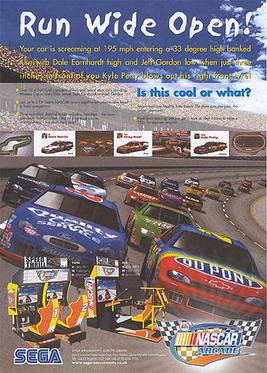
NASCAR Arcade, initially known as NASCAR Rubbin' Racing outside North America, is a 2000 racing arcade game developed by Sega Rosso and released by Sega. It was produced at the suggestion of producer Kenji Arai, and the soundtrack was produced by Jun Senoue. The game is based on NASCAR, and carries an official license with permission from EA Sports, which permitted Sega to develop the game as a coin-op only title.
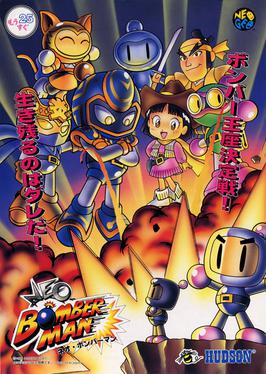
Neo Bomberman is an action-maze arcade video game developed by Produce! and published by Hudson Soft for the Neo Geo MVS on May 1, 1997. It is one of two games in the Bomberman franchise that was released for the Neo Geo platform, the first being Panic Bomber, and the only one to retain its traditional top-down gameplay. It was released for the Neo Geo MVS (arcade) and has not received a home console release to date. It was the last original Bomberman title to be released for arcades until Konami's Bombergirl in 2018.

Aliens is a 1990 run and gun video game developed and published for arcades by Konami. It is based on the 1986 film of the same title. Two players can play the game cooperatively in addition to single-player.

Racing Hero is a 1989 arcade racing game from Sega which runs on the Sega X Board hardware. In Racing Hero, the player takes part in an international race aboard a motorcycle and races against time and other vehicles. It draws much inspiration from Sega's successful Hang-On and Out Run series.
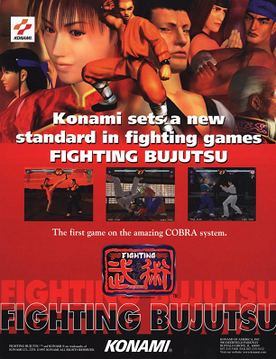
Fighting Bujutsu, known in Japan as Fighting Wu-Shu, is an August 1997 3D fighting arcade game developed and published by Konami. It is Konami's second attempt in the 3D fighting game market, after their 1996 Lightning Legend: Daigo no Daibouken, and was released only in arcades.

Gun Beat is an unreleased action-racing video game previously under development by Treasure for the Sega NAOMI arcade platform. The game was revealed in February 1999 at an arcade trade show in Japan alongside several other games to promote Sega's new arcade board. Gun Beat was not playable, but a gameplay video was on display. The demo reel was well received by critics who felt the game carried the same quirky characteristics and quality artwork of previous Treasure offerings. Development on the game was ceased indefinitely in May 2000 with little explanation.
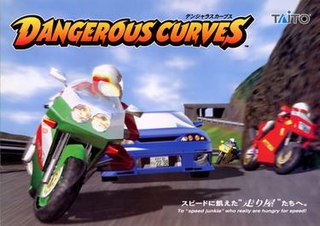
Dangerous Curves is an arcade racing game developed and published by Taito. The arcade cabinet is constructed to allow players to choose between simulating either a car or a motorcycle and then race other vehicles on a variety of courses.
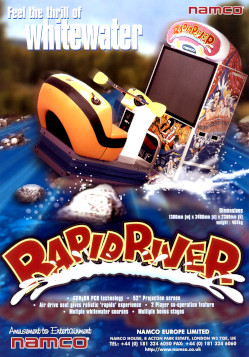
Rapid River is a 1997 arcade game released by Namco. The game is about white water rafting, and players must race against the clock, passing through checkpoints to extend the time they have to complete the level. The game is notable for its unique player controls that aim to replicate oars. It was intended to appeal to dating couples. The game is one of only two known games to run on Namco Gorgon hardware, an early revision of the Namco System 23 hardware. A virtual reality remake was released by Bandai Namco Amusement in 2018 for its VR Zone arcade centers.
References
- 1 2 3 "JAEPO - Japan Amusement Expo 2014". Highway Games. Retrieved 14 March 2016.
- ↑ Business Japan. Vol. 27. Nihon Kogyo Shinbun. 1982. pp. 75, 85.
- ↑ Business America. Vol. 4. United States Department of Commerce. 1981. p. 34.
- 1 2 "Amusement Show, Vol. 49". am-show.jp. 2011. Archived from the original on 19 April 2015.
- 1 2 "第49回アミューズメントマシンショー開幕" [49th Amusement Machine Show Kicks Off]. Gigazine (in Japanese). 15 September 2011. Retrieved 14 March 2016.
- ↑ "AOU 2012". aou.or.jp (in Japanese). All Nippon Amusement Machine Operators' Union. Retrieved 14 March 2016.